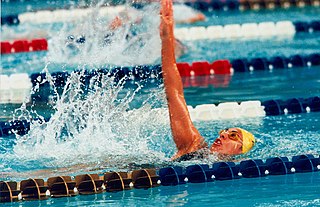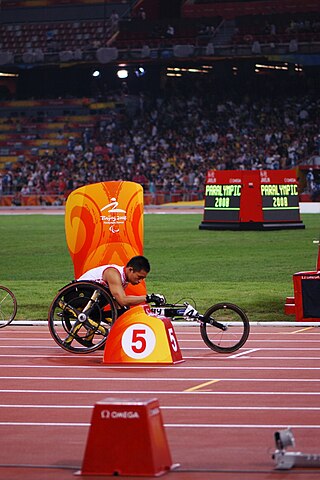
S8, SB7, SM8 are para-swimming classifications used for categorizing swimmers based on their level of disability. This class includes a number of different disabilities including people with amputations and cerebral palsy. The classification is governed by the International Paralympic Committee, and competes at the Paralympic Games.

S7, SB6, SM7 are para-swimming classifications used for categorizing swimmers based on their level of disability. Swimmers in this class have use of their arms and trunk. They have limited leg function or are missing a leg or parts of both legs. This class includes a number of different disabilities including people with amputations and cerebral palsy. The classification is governed by the International Paralympic Committee, and competes at the Paralympic Games.
S6, SB5, SM6 are para-swimming classifications used for categorising swimmers based on their level of disability. This class includes people with a number of different types of disability including short stature, major limb impairment or loss in two limbs. This includes people with cerebral palsy, people with dwarfism and amputees. The class competes at the Paralympic Games.
S5, SB4, SM5 are para-swimming classifications used for categorizing swimmers based on their level of disability. The class includes people with a moderate level of disability, and includes people with full use of their arms and hands, but limited to no use of their trunk and legs. It also includes people with coordination problems. A variety of disabilities are represented by this class including people with cerebral palsy. The class competes at the Paralympic Games.
S4, SB3, SM4 are para-swimming classifications used for categorising swimmers based on their level of disability. Swimmers in this class have coordination problems affecting all four of their limbs, or have movement in their arms, some trunk function and no leg function. Events this class can participate in include 50m and 100m Freestyle, 200m Freestyle, 50m Backstroke, 50m Butterfly, 50m Breaststroke, and 150m Individual Medley events. The class competes at the Paralympic Games.
S3, SB2, SM3 are para-swimming classifications used for categorising swimmers based on their level of disability. People in this class have some arm and hand function, but no use of their trunk and legs. They have severe disabilities in all their limbs. Swimmers in this class have a variety of different disabilities including quadriplegia from spinal cord injury, cerebral palsy and multiple amputations.
T52 is disability sport classification for disability athletics. People in this class have good shoulder and upper body control, but lack fine motor skills in their arms and hands. They have no or limited trunk and leg function. The class includes people with a number of different types of disabilities including spinal cord injuries. Similar classifications are T51, T53 and T54.

T53 is disability sport classification for disability athletics. The class includes people with a number of different types of disabilities including spinal cord injuries. People in this class have full use of their arms but have no or limited trunk function. Similar classifications are T51, T52, and T54. People in this class have a functional upper limbs, but limited trunk usage and limited lower limb functionality. During classification, they both undergo a bench test of muscle strength and demonstrate their skills in athletics. People in this class include Tanni Grey-Thompson (GBR), Samantha Kinghorn (GBR), Angie Ballard (AUS) and Richard Colman (AUS).
Wheelchair fencing classification is the classification system for wheelchair fencing which is governed by the IWAS. People with physical disabilities are eligible to compete included people with physical disabilities. Classification for national competitions is done through the local national Paralympic committee.
F57 is a disability sport classification for disability athletics for people who compete in field events from a seated position. This class is for people with limb deficiencies not covered by other classes. It includes people who are members of the ISOD A1 and A9 classes. Events open to people in this class include the shot put, discus and javelin.
F56 is a disability sport classification for disability athletics for people who compete in field events from a seated position. The seating field event class used to be known as lower 4, upper 5. Different disability groups compete in this class, including people with amputations and spinal cord injuries. Events that may be on the program for F56 competitors include the discus throw, shot put and javelin.
F55 is a disability sport classification for disability athletics for people who compete in field events from a seated position. Sportspeople in this class have full arm function, partial trunk function and no lower limb function. Different disability groups compete in this class, including people with spinal cord injuries. The classification was previously known as lower 3, upper 4.
F1, also T1 and SP1, is a wheelchair sport classification that corresponds to the neurological level C6. Historically, it was known as 1A Complete. People in this class have no sitting balance, and are tetraplegics. They may be able to perform limited actions with one hand. They lack sitting balance, and have limited head control and respiratory endurance. The process for classification into this class has a medical and functional classification process. This process is often sport specific.
F2, also T2 and SP2, is a wheelchair sport classification that corresponds to the neurological level C7. Historically, it was known as 1B Complete, 1A Incomplete. People in this class are often tetraplegics. Their impairment effects the use of their hands and lower arm, and they can use a wheelchair using their own power.
F3, also T3 and SP3, is a wheelchair sport classification that corresponds to the neurological level C8. Historically, it was known as 1C Complete, and 1B Incomplete. F3 sportspeople have functional issues related to the muscles in their throwing arm, though they have enough control over their fingers to grip a throwing implement normally. They have no functional trunk control.
F4, also T4 and SP4, is a wheelchair sport classification that corresponds to the neurological level T1- T7. Historically, it was known as 1C Incomplete, 2 Complete, or Upper 3 Complete. People in this class have normal upper limb function, and functional issues with muscles below the nipple line.
F5, also SP5, is a wheelchair sport classification that corresponds to the neurological level T8 - L1. Historically, it was known as Lower 3, or Upper 4. People in this class have some trunk function and good sitting balance. They have problems with hip function, that reduces their ability to rotate their spines.
F6, also SP6, is a wheelchair sport classification that corresponds to the neurological level L2 - L5. Historically, this class has been known as Lower 4, Upper 5. People in this class have good sitting balance, and good forward and backward movement of their trunk. They have some use of their thighs and can press their knees together.
F8, also SP8, is a standing wheelchair sport classification open to people with spinal cord injuries, with inclusion based on a functional classification on a points system for lower limb functionality. Sportspeople in this class need to have less than 70 points. The class has largely been used in Australia and the United States. F8 has largely been eliminated because of a perceived lack of need internationally for a standing wheelchair class. Sports this class participates in include athletics, swimming and wheelchair basketball. In athletics, participation is mostly in field events.
Wheelchair sport classification is a system designed to allow fair competition between people of different disabilities, and minimize the impact of a person's specific disability on the outcome of a competition. Wheelchair sports is associated with spinal cord injuries, and includes a number of different types of disabilities including paraplegia, quadriplegia, muscular dystrophy, post-polio syndrome and spina bifida. The disability must meet minimal body function impairment requirements. Wheelchair sport and sport for people with spinal cord injuries is often based on the location of lesions on the spinal cord and their association with physical disability and functionality.








